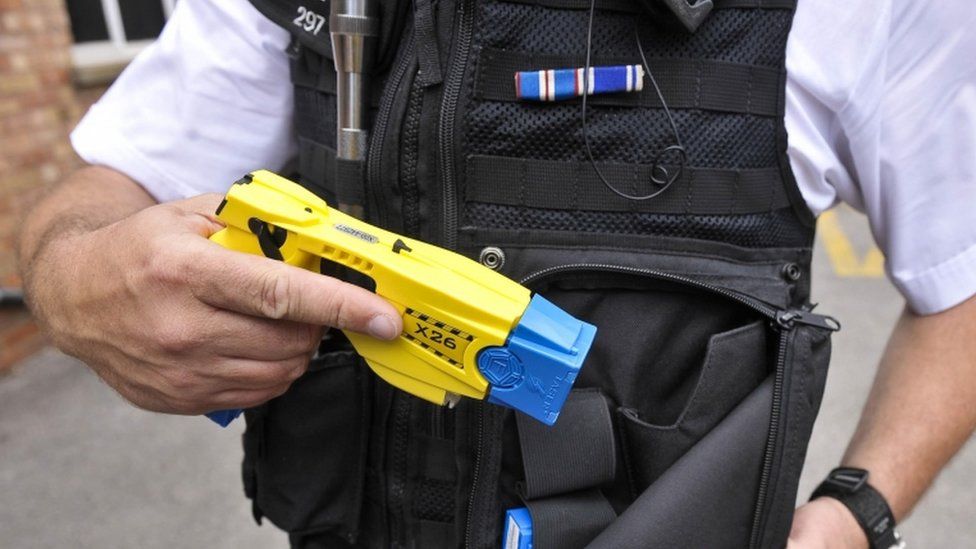Police need clearer guidance on Tasers – watchdog

Police forces must be given clearer guidance about when they can use Tasers to control suspects, according to the police watchdog.
The Independent Office for Police Conduct (IOPC) has reviewed controversial cases of Taser use.
It found black people were more likely to face a Taser and some officers were not considering the risk of injury to vulnerable people.
But police chiefs say the IOPC report is vague and lacking in detail.
The National Police Chiefs Council said the IOPC report only looked at a fraction of Taser use.
The IOPC is warning that the use of Tasers risks losing its legitimacy in the eyes of the public if the concerns are not addressed.
And it said Tasers have been used in “unsafe locations or circumstances”, and too often to get suspects to do what the police are asking, rather than in response to a physical threat.
The report also raises concerns about the use of Tasers on children.
In the 108 cases examined:
- 94 people had a Taser “discharged” at them
- 22% of subjects were Black, and 71% white, representing a “disproportionate” use of the device. However black people were less likely than white people to actually be Tasered, despite being more likely to face a police Taser
- Eight involved the Taser being discharged for more than 20 seconds, and for 67 seconds in one case
- Half of suspects were Tasered more than once.
- Six children were involved
- Mental health was a factor in more than half of the cases
- 14 cases involved the use of a Taser against someone in a “potentially unsafe position”, including when there was a risk of them falling from height when stunned. One man fell into a river after being Tasered, and the device discharged four times while he was in the water.
- A third of cases involved officers making “inappropriate comments” or “communicating inappropriately”
- In 26 cases passed to the IOPC, potential poor practice or illegal use of Tasers was identified.
- In 15 there was a case for gross misconduct.
- 25 officers were referred to the Crown Prosecution Service for a decision about whether they should be charged with an offence.
The IOPC’s director, Michael Lockwood said: “People from black, Asian and minority ethnic backgrounds deserve a clear and transparent answer from police on why such disproportionality still exists – failure to address this risks undermining the legitimacy of policing.”
Home Office data shows large increases in Taser use, and greater numbers of officers being trained to use them. The number of incidents where they have been used doubled to around 32,000 in 2019/20.
The device also featured prominently in the recent court case of police officer Benjamin Monk, who was convicted of manslaughter when he kicked to death the former footballer Dalian Atkinson. This followed an “excessive” 33-second Taser deployment.
The inquest into the death of Marc Cole also found that a Taser played a part in his death.
Mr Cole died after suffering a cardiac arrest in 2017, following use of Taser for a total of 43 seconds. He had been experiencing a mental health crisis and was self-harming during the incident.
Some senior police officers are increasingly advocating that all officers should carry a Taser to protect them.
The report says: “We found in some cases that officers failed to identify, and as a result failed to consider, how a person’s vulnerabilities might affect their ability to understand and comply with instructions.”
It also concludes: “Taser should not be used merely to elicit compliance with instructions or procedures where there is no threat, or the threat has been substantially reduced to the point where it is no longer proportionate or necessary.”
Four inquests in recent years found that Tasers contributed to a person’s death.
The report recommends senior police officers re-examine the types of situations where a Taser should not be used, in particular, when vulnerable people or children are involved.
The IOPC also wants police to consider how officers can further reduce the risk of using the devices, and reinforce that they should not be used to obtain compliance.
The College of Policing, which considers police policy, has been asked to examine the implications of the report with regard to race.
Another recommendation is that police create “scrutiny panels” to examine the use of Tasers, which should be independently chaired by members of the public and reflective of communities.
But the National Police Chiefs Council criticised the report. Chief Constable Luci D’Orsi said it “regrettably ignores extensive pieces of work that are already well under way and, indeed, other areas where improvement could be made”.
She said she had advised the IOPC of her concerns.
She said: “I am extremely disappointed that it did not engage with policing, attend a Taser training course or consult the national independent experts who we work with whilst undertaking its initial research.”
“Only 101 Taser uses over a five year period were reviewed and these were all ones that had been investigated by the IOPC. It is concerning that this only represents 0.1 per cent of all Taser uses in the same period, which totals 94,045.”
Source: (BBC News)

